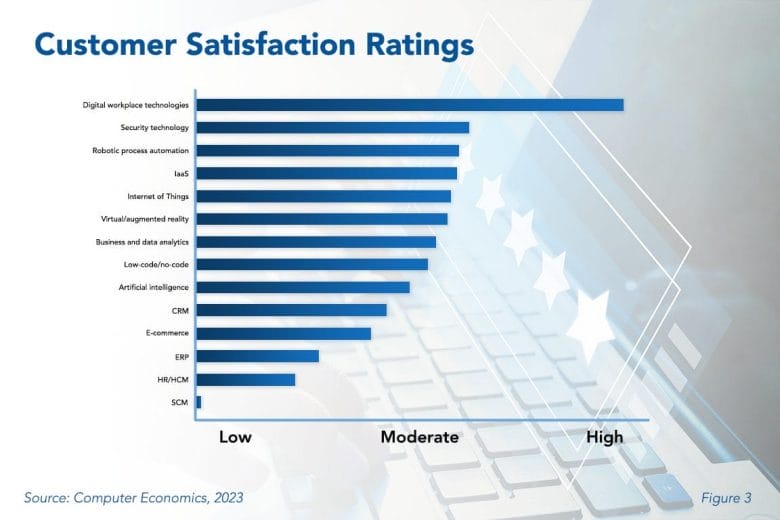Global supply chain disruptions are disrupting supply chain management (SCM) investments. Unable to keep up with the pace of change, SCM systems have the lowest satisfaction rating.
As shown in Figure 3 from our study, SCM is at the very bottom of the satisfaction list. This is a new result this year. Digital workplace technologies take the top spot for the second year in a row. The ratings are based on the percentage of companies saying they are satisfied or very satisfied with their experience with each of the 14 technologies in our survey. The satisfaction ratings are based on a relative scale determined by the highest and lowest values for all technologies in the study.

Historically, SCM systems were developed to support the procurement and distribution of direct materials—materials used in products for sales to customers. The systems were built to support the planning, movement, and storage of materials from the earliest stages of procurement through the intermediate stages of production to final distribution to the end customer. While ERP systems primarily focus on the internal operations of the business, SCM looks outward to encompass the activities of suppliers, customers, and partners, as well as internally to the movement and storage of materials within the organization’s operations. Such systems fall into two main subcategories:
-
- Supply chain planning systems support the planning of supply and demand, both within the production facility and across the supply chain. These systems often incorporate concepts and techniques such as demand forecasting, predictive analytics, rapid simulation, theory of constraints, demand-driven material requirements planning, in-memory computing, and linear programming.
- Supply chain execution systems carry out those plans on a day-to-day or hour-by-hour basis and react to events or disruptions. These systems can incorporate several technologies, such as bar-coding, RFID, conveyor systems, warehouse automation, automated material handling systems, robotics, global positioning systems, AI, and machine-to-machine communications.
Unfortunately, both planning and execution were sorely tested this year by global disruptions from the war in Ukraine, COVID outbreaks in China and elsewhere, and other factors. Not surprisingly, satisfaction went south.
“Of course, it is not all the fault of SCM,” said David Wagner, senior research director for Computer Economics, a service of Avasant, based in Los Angeles. “The software can only do so much. We are seeing responses to these crises including nearshoring, diversification of manufacturing and supply chains, and adoption of more predictive AI.”
The best supply chains feature smart business processes and resiliency. But looking for SCM with prescriptive AI can certainly help, not only by warning of potential disruptions but also by suggesting new suppliers, rerouting existing supply, and providing real-time demand forecasts.
The full study gives business leaders insight into the staying power of 14 technologies that are currently top of mind for many companies. It provides a glimpse into how quickly an emerging technology is being adopted, how deeply more-established technologies are penetrating the market, and how positive the customer experience is with each technology. The study also delves into the specific types of solutions under consideration.
By understanding the adoption trends, investment activity, and customer experience, business leaders are in a better position to assess the potential risks and rewards of investing in each of these technology initiatives. They also can gain insight into just how aggressively competitors and peers are investing in these initiatives.
The full study also takes a quick look at an additional 17 early adopters and emerging technologies. These include digital currencies, biometric identification, 3-D printing, drones, autonomous vehicles, 5G private networks, blockchain, AI robotics, Wi-Fi 6, digital twins, non-fungible tokens, quantum computing, holograms, self-healing systems, human-computer integration, ultra-high-density storage, and 6G networks. The study evaluates whether IT decision-makers are familiar with these, whether they see a potential use for them, and whether they have already implemented them or have them installed.
Sample Pages from the full study are available for free download.
This Research Byte is a brief overview of our study, Technology Trends 2023. The full report is available at no charge for subscribers, or it may be purchased by non-clients directly from our website (click for pricing).

